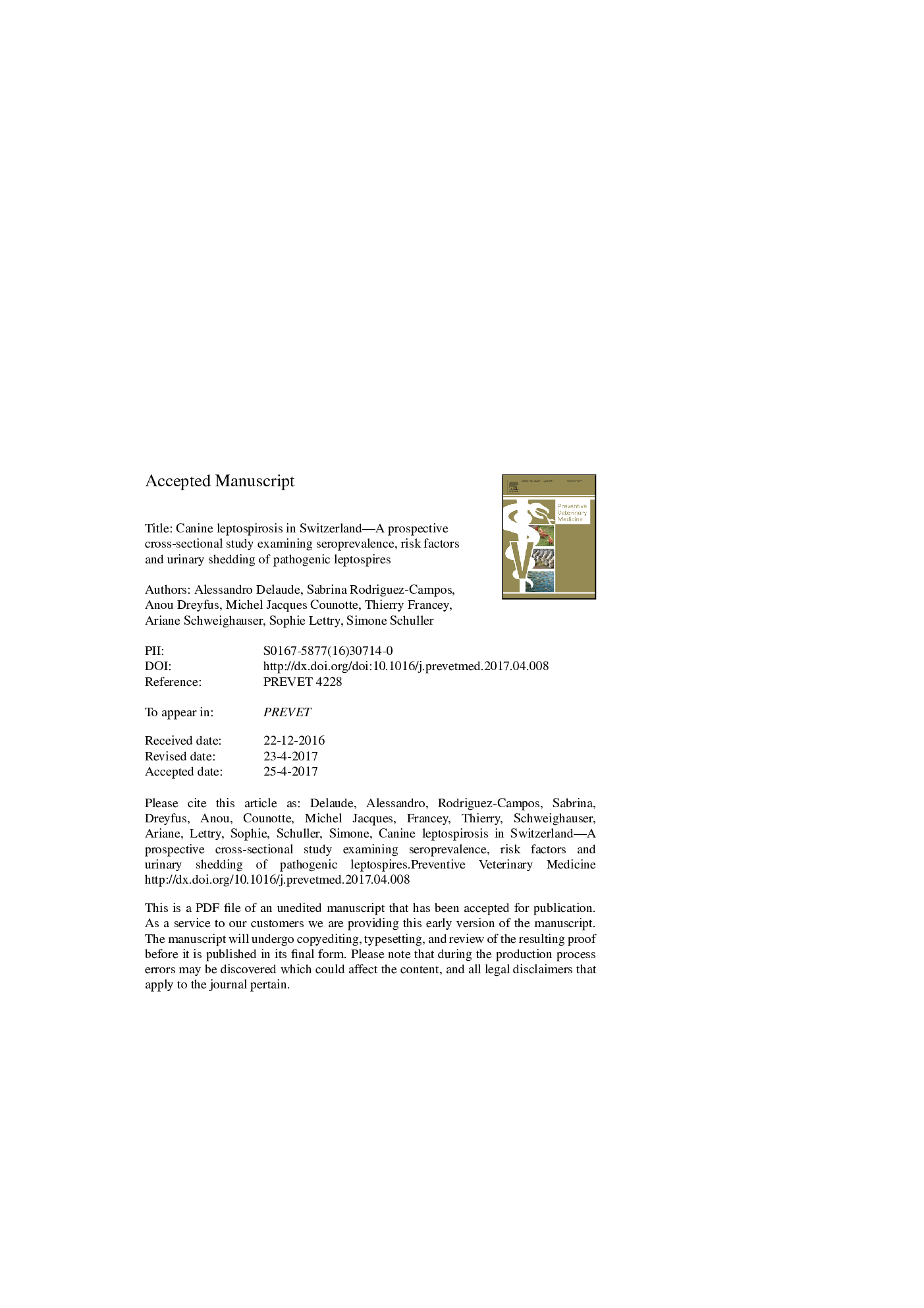| کد مقاله | کد نشریه | سال انتشار | مقاله انگلیسی | نسخه تمام متن |
|---|---|---|---|---|
| 5543774 | 1554149 | 2017 | 44 صفحه PDF | دانلود رایگان |
عنوان انگلیسی مقاله ISI
Canine leptospirosis in Switzerland-A prospective cross-sectional study examining seroprevalence, risk factors and urinary shedding of pathogenic leptospires
دانلود مقاله + سفارش ترجمه
دانلود مقاله ISI انگلیسی
رایگان برای ایرانیان
کلمات کلیدی
موضوعات مرتبط
علوم زیستی و بیوفناوری
علوم کشاورزی و بیولوژیک
علوم دامی و جانورشناسی
پیش نمایش صفحه اول مقاله

چکیده انگلیسی
Leptospirosis is an important worldwide zoonosis. While human leptospirosis remains rare in Switzerland, the incidence of canine leptospirosis is unusually high compared to other European countries. The aims of this cross-sectional study were to determine the exposure of asymtomatic dogs to pathogenic Leptospira in Switzerland, to characterise risk factors associated with seropositivity and to determine the prevalence of urinary shedding. Sampling was stratified to cover the whole of Switzerland. Sera were tested by microscopic agglutination test for antibodies against a panel of 12 serovars. Urine was tested for pathogenic Leptospira using a LipL32 real-time PCR. Of 377 sera, 55.7% (95%CI 51.2-60.7) showed a reciprocal MAT titre of â¥1:40 and 24.9% (95%CI 20.7-29.4) of â¥1:100 to at least one serovar. Seropositivity (MAT â¥1:100) was most common to serovars Australis (14.9%; 95% CI 11.4-18.6) and Bratislava (8.8%; 95%CI 6.1-11.7), followed by Copenhageni (6.1%; 95%CI 3.7-8.5), Canicola (5%; 95%CI 2.9-7.4), Grippotyphosa (4.5%; 95%CI 2.7-6.9), Pomona (4%; 95%CI 2.1-6.1), Autumnalis (2.7%; 95%CI 1.3-4.2) and Icterohaemorrhagiae (1.6%; 95%CI 0.5-2.9). In unvaccinated dogs (n = 84) the prevalence of a MAT titre â¥100 was 17.9% (95%CI 10.7-26.2), with a similar distribution of reactive serovars. Variables associated with seropositivity (â¥1:40) to any serovar included age (OR 1.29/year; 95%CI: 1.1-1.5) and bioregion with higher risks in the regions Northern Alps (OR 14.5; 95%CI 2.2-292.7), Central Plateau (OR 12.3; 95%CI 2.0-244.1) and Jura (OR 11.2; 95%CI 1.7-226.7) compared to Southern Central Alps. Dogs living with horses were significantly more likely to have antibodies to serovar Bratislava (OR 4.68;95%CI 1.2-17.2). Hunting was a significant risk factor for seropositivtiy to serovar Grippotyphosa (OR 8.03; 95%CI 1.6-30.8). Urine qPCR positivity was uncommon (1/408 dogs; 0.2%; 95% CI0-0.7). These results demonstrate that dogs in Switzerland are commonly exposed to pathogenic Leptospira; however, the risk of dogs contributing to the spread of Leptospira in the environment appears low.
ناشر
Database: Elsevier - ScienceDirect (ساینس دایرکت)
Journal: Preventive Veterinary Medicine - Volume 141, 1 June 2017, Pages 48-60
Journal: Preventive Veterinary Medicine - Volume 141, 1 June 2017, Pages 48-60
نویسندگان
Alessandro Delaude, Sabrina Rodriguez-Campos, Anou Dreyfus, Michel Jacques Counotte, Thierry Francey, Ariane Schweighauser, Sophie Lettry, Simone Schuller,